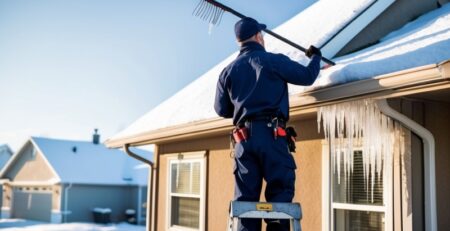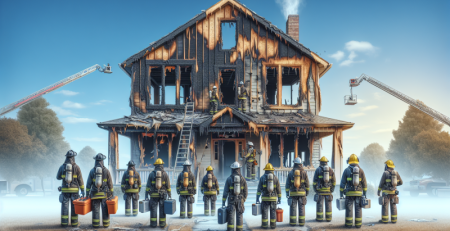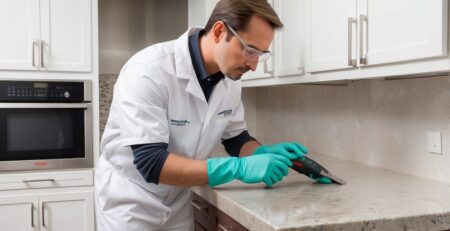How to Prepare Your Home for a Flood
Flooding can be a devastating experience for homeowners, leading to significant property damage and emotional distress. Preparing your home for a flood is essential to minimize potential losses and ensure the safety of your family. At Kraus Restoration, NJ’s leaders in water damage restoration, we understand the importance of proactive measures in safeguarding your property against flooding. Our mission is to assist those affected by water damage, providing expert guidance and 24/7 emergency services to restore homes and lives back to normal. In this blog, we will explore effective strategies to prepare your home for a flood, including assessing your property’s vulnerability, creating an emergency plan, and implementing preventive measures. By taking these steps, you can protect your home and loved ones from the devastating effects of flooding. Trust Kraus Restoration to be your partner in recovery, ensuring that you are ready for whatever nature may bring. Flooding often leads to sewage system overloads and backups. Preparation can prevent this nightmare.
Assessing Your Flood Risk and Creating a Plan
Flooding can be a devastating natural disaster that affects homes and communities across the globe. Understanding your flood risk is the first step in preparing your home for such an event. Flood risk varies significantly depending on geographic location, climate conditions, and local infrastructure. To effectively assess your flood risk, you should consider several factors, including historical data, flood zone maps, and local weather patterns.
Start by researching the flood history of your area. The Federal Emergency Management Agency (FEMA) provides flood maps that categorize areas based on their risk levels. These maps can help you determine whether your home is located in a high-risk flood zone, which is often defined as an area with a 1% or greater chance of flooding in any given year. According to FEMA, approximately 20% of flood insurance claims come from properties outside of high-risk flood zones, highlighting the importance of understanding your specific situation.
In addition to FEMA maps, local government agencies often provide resources and information about flood risks in your area. These resources may include community floodplain management plans, which outline strategies for reducing flood risks and improving resilience. Engaging with local authorities can provide insights into recent flood events and any ongoing mitigation efforts.
Another critical aspect of assessing your flood risk is considering the topography and drainage systems in your vicinity. Areas with poor drainage or those that are prone to flash flooding may require additional precautions. If your home is situated near a river, lake, or other body of water, it is essential to monitor water levels and understand how they can impact your property.
Once you have a clear understanding of your flood risk, the next step is to create a comprehensive flood preparedness plan. This plan should include several key components:
- Emergency Contacts: Compile a list of emergency contacts, including local emergency services, family members, and neighbors. Ensure that everyone in your household knows how to reach these contacts in case of an emergency.
- Evacuation Routes: Identify multiple evacuation routes from your home to higher ground. Familiarize your family with these routes and practice them regularly.
- Emergency Kit: Prepare an emergency kit that includes essential supplies such as water, non-perishable food, medications, flashlights, batteries, and important documents. Store this kit in an easily accessible location.
- Home Inventory: Create a detailed inventory of your possessions, including photographs and receipts. This documentation can be invaluable for insurance claims in the aftermath of a flood.
- Insurance Review: Review your homeowner’s insurance policy to ensure it covers flood damage. If you live in a high-risk area, consider purchasing flood insurance through the National Flood Insurance Program (NFIP).
- Flood-Proofing Measures: Implement flood-proofing measures in your home, such as elevating electrical systems, installing sump pumps, and using flood barriers. These steps can help minimize damage during a flood event.
Creating a flood preparedness plan is not just about protecting your property; it is also about ensuring the safety of your family. Regularly review and update your plan, especially after significant weather events or changes in your local environment.
In conclusion, assessing your flood risk and creating a comprehensive plan are essential steps in preparing your home for a flood. By understanding the specific risks associated with your location and taking proactive measures, you can significantly reduce the impact of flooding on your home and family. For more information on flood preparedness and restoration services, visit Kraus Restoration or contact us for personalized assistance. Remember, being prepared can make all the difference when disaster strikes.
For further reading on flood preparedness, you can explore resources from FEMA and the National Oceanic and Atmospheric Administration (NOAA). These organizations provide valuable information on flood risks, safety tips, and recovery resources.
By taking the time to assess your flood risk and create a well-thought-out plan, you are not only protecting your home but also ensuring peace of mind for you and your loved ones.
Essential Preparations and Safety Measures for Your Home
Preparing your home for a flood is a critical step in safeguarding your property and ensuring the safety of your family. Flooding can occur suddenly and with little warning, making it essential to have a comprehensive plan in place. The first step in flood preparation is to assess your home’s vulnerability. Identify if your property is located in a flood-prone area by checking local flood maps and historical data. This knowledge will help you understand the level of risk you face and guide your preparations accordingly.
Once you have assessed your risk, consider elevating critical utilities such as electrical panels, water heaters, and heating systems above potential flood levels. This can significantly reduce the risk of damage during a flood. Additionally, installing sump pumps and backflow valves can help manage water intrusion. It is also wise to create a flood emergency kit that includes essential supplies such as water, non-perishable food, medications, flashlights, batteries, and important documents. Keep this kit in a waterproof container and ensure all family members know its location.
Another vital preparation step is to develop an evacuation plan. Identify multiple routes out of your neighborhood and establish a meeting point for your family in case you become separated. Practice this plan regularly to ensure everyone knows what to do when a flood warning is issued. It is also important to stay informed about weather conditions and flood alerts. Sign up for local emergency alerts and monitor weather forecasts to receive timely updates.
In addition to these preparations, consider flood-proofing your home. This can include installing flood barriers, using water-resistant building materials, and sealing cracks in your foundation. Landscaping can also play a role in flood prevention; ensure that your yard slopes away from your home and that gutters and downspouts direct water away from the foundation. Regular maintenance of these systems is crucial to ensure they function effectively during heavy rains.
Insurance is another critical aspect of flood preparation. Standard homeowners insurance policies typically do not cover flood damage, so it is essential to purchase separate flood insurance. Review your policy to understand what is covered and consider increasing your coverage if necessary. Document your possessions with photographs and keep an inventory to facilitate claims if needed.
Finally, after a flood, it is important to prioritize safety. Avoid entering flooded areas until authorities declare them safe. If your home has been affected, contact professionals for water cleanup and mold cleanup services to address any damage and prevent further issues. Remember that preparation is key to minimizing the impact of flooding on your home and ensuring the safety of your loved ones. By taking these essential steps, you can create a safer environment and be better equipped to handle the challenges that come with flooding. For more information on how to protect your home and family, feel free to contact us.
In conclusion, preparing your home for a flood is a crucial step in safeguarding your property and ensuring the safety of your loved ones. By taking proactive measures such as assessing your flood risk, creating an emergency plan, elevating important utilities, and securing your belongings, you can significantly reduce the potential damage caused by flooding. Additionally, staying informed about local weather conditions and flood alerts will help you respond swiftly in case of an emergency. Remember, preparation is key; investing time and effort into flood preparedness today can make all the difference tomorrow. Stay safe, stay informed, and take action to protect your home from the unpredictable forces of nature.










